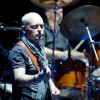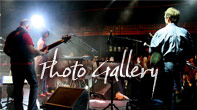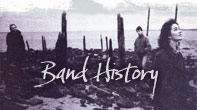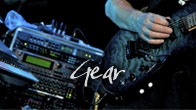Martin's Gear
Martin Nolan took some time away to answer a few questions related to his Iona gear.Strict Standards: Non-static method Photos::getPhotoUrl() should not be called statically, assuming $this from incompatible context in /var/www/iona/application/views/scripts/common/photo-single.phtml on line 6
Martin Nolan: Uilleann Pipes / Low & Tin Whistles
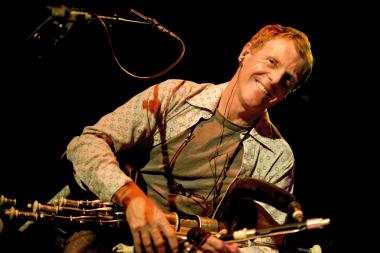
Q. Can you tell us something about the instruments you play, Martin?
The uilleann (pronounced "ill - in": 'elbow' in the Gaelic language of Ireland) pipes are my main instrument and the most developed member of the bagpipe family worldwide. The low whistles were invented by the late Bernard Overton and the nearest I can come to playing flute without falling over from hyper-ventilation (former member Troy Donnockley also plays low whistles made by Overton). The fingering and positioning to the front of the body, rather than up to the side like a flute, makes it more like playing the chanter and therefore less of a challenge than playing flute. Being made from aluminium also gives it a very definite sound of it's own; somewhere between the depth of the wooden flute and the brightness of the silver flute. My pipes (concert pitch D and flat pitch C) are made by Andreas Rogge of Tuebingen, Germany, and my low whistles (C, D and E) by Cillian O'Briain in Dingle, Co Kerry. I also use a set of Syn whistles: bodies of various keys of tin whistles with one interchangeable mouthpiece. My pipes are amplified internally by a Shure SM11 lavalier microphone, recommended and successfully implemented by the magical Johan van Loo (Iona's Dutch sound engineer).Strict Standards: Non-static method Photos::getPhotoUrl() should not be called statically, assuming $this from incompatible context in /var/www/iona/application/views/scripts/common/photo-single.phtml on line 6

Martin's Uilleann Pipes, 2010
Q. The uilleann pipes have a very unique sound - more mellow than the highland pipes, for example. Can you explain the different techniques compared to pipes using the mouth?
The uilleann pipes are played in a sitting position (although I have been known to move about a bit when over-excited). A bellows strapped to one elbow is used to inflate the bag which is in turn pressed by the other elbow to force air through the reeds in the pipes. I understand that the chanter, which is the melody section of the instrument, evolved from the English pastoral pipe. The double reed in the chanter is capable of two octaves by slightly increasing the bag pressure,which is, I believe, unique to the uilleann pipes. Other bagpipes are either confined to approximately one octave or achieve a second octave by the use of keyed notes on the chanter. The drones -- tenor, baritone and bass -- were an addition to this, followed by three 'mini chanters' known as 'regulators' and arranged so that simple chord accompaniment can be achieved by pressing on keys with the wrist while still using both hands to play the melody. There are three double reeds in the regulators and three single reeds in the drones, seven in total. William Kennedy from Armagh is credited with developing the instrument to its current state in the late 1700's.Strict Standards: Non-static method Photos::getPhotoUrl() should not be called statically, assuming $this from incompatible context in /var/www/iona/application/views/scripts/common/photo-single.phtml on line 6

My First Pipes, '70s
Q. Are there some restrictions with the keys or notes that can be played on the pipes?
Theoretically the chanter is chromatic but in fact does not lend itself very well to chromatic playing. I believe this is due mainly to the fact that all of the main note holes are covered directly with fingers rather than by keys (as on a saxophone, for example). The reed also needs to be coaxed by increased bag pressure into playing the higher octave and so 'jumping' from one octave to another is not as easily or reliably achieved as it is on other instruments which are mouth blown and/or have "speaker" keys ( again I would cite the sax as an example).Strict Standards: Non-static method Photos::getPhotoUrl() should not be called statically, assuming $this from incompatible context in /var/www/iona/application/views/scripts/common/photo-single.phtml on line 6

Martin's Band Fionnuisce, '70s
Q. You come from a traditional Irish music background. Can you tell us a bit about this?
In the late 60's early 70's there was a renaissance in the traditional Irish music scene and I became interested in the pipes after hearing a live recording of Sean O'Riada and his group Ceoltoiri Chualainn. This was a landmark recording which changed the course of traditional Irish music in much the same way that Miles Davis changed the course of jazz. I started learning tin whistle from Mary Bergin in Dublin and was also fortunate enough to meet an amazing piper called Paddy Keenan who arranged for me to have lessons from his father John. John lived about 2 miles from my home and I walked or cycled to his home once, sometimes twice, each week for my lesson. I would then practice what I had learned with his son Thomas until late in the night and then make my way home. This practice time is what helped develop my style of playing, known as the Travelling Style, a mixture of legato and staccato playing with lots of variations on the basic melody. We would play each tune over and over and faster and faster, changing it slightly each time, until the fingers were moving much faster than the brain, at least that's what it felt like. At the same time Dublin city was alive with music sessions in pubs and it was very easy to get to hear great musicians playing almost every night of the week. As my ability and repertoire improved I joined in on some of these sessions and met other players of my own age. The first band I was in, Fionnuisce, was formed from friendships forged in these sessions. I still play regularly with many of those musicians. There were many festivals around the country towns during the summer period and, unlike festivals today which have big attractions and stages and sound systems, these were just lots of casual sessions in pubs around whichever town the festival happened to be in. Although the euphoria of those days has long since faded, traditional music is in a very healthy condition today with many highly talented young players keeping the music alive by playing both old favourites and new compositions side by side.Strict Standards: Non-static method Photos::getPhotoUrl() should not be called statically, assuming $this from incompatible context in /var/www/iona/application/views/scripts/common/photo-single.phtml on line 6
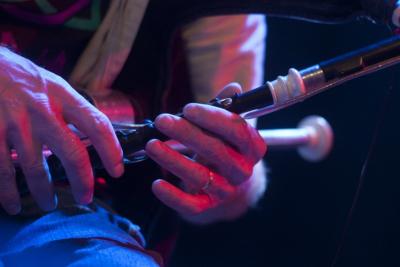
Another Realm Tour, Netherlands 2011
Q. What are the challenges in playing with Iona both live and in the studio and what are the things you really like about being in the band?
Playing live is more challenging than recording, but also more fun. The musical arrangements are quite complex and exacting with lots of pipe or whistle fills in the songs: I'm used to playing complete tunes from start to finish without having to remember which fill goes where, so I need to focus more with Iona than with any other band I've worked with. The touring schedules have been quite erratic since we've re-formed, with long gaps between short tours and this makes it difficult to get completely comfortable with the music. I don't like having music notation or song charts on stage but I've had to do this regularly with IonLast year touring the US for two weeks in June was great for me as we played almost every night and pretty soon into the tour I was working completely from memory and playing more naturally and freely - the way I play Irish music. However, the following gigs were not until the autumn and it felt like I was starting from scratch again - well, almost. My fingers had remembered more than I thought they would, so I just had to have the courage to "let go" of the charts and trust my fingers. Not easy to do live as I feel that if I make a mistake I'm letting the others in the band down as well as myself. I know I have said this before but all of the band members have been very supportive and encouraging to me and I am very grateful for that.Strict Standards: Non-static method Photos::getPhotoUrl() should not be called statically, assuming $this from incompatible context in /var/www/iona/application/views/scripts/common/photo-single.phtml on line 6
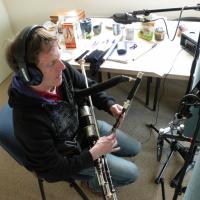
Another Realm Sessions, 2010
Strict Standards: Non-static method Photos::getPhotoUrl() should not be called statically, assuming $this from incompatible context in /var/www/iona/application/views/scripts/common/photo-single.phtml on line 6

Nearfest (US), 2010
Being in the studio with Iona presented a different set of challenges for me. Because I was now working in a new genre of music and surrounded by such talented and experienced artists of this genre I felt inclined to take a back seat, so to speak, and let them do the driving. If I had any ideas I would speak out, but otherwise was happy to observe. Recording the album in various studios, with arrangements and parts of "works in progress" being sent through the internet for comment or suggestion, was also new to me. There was only one time at the very start of recording 'Another Realm' that we were all together in the same studio, Johan van Loo's studio in Holland, for a week. On other occasions I had a few days at Jo's and also at Dave's studio in England recording written parts and creating some new ones. I recorded the pipe part for 'Let the Waters Flow" in my own attic studio and sent it to Dave for mixing and editing.
Q. Stepping into Troy's shoes must have been quite daunting, yet with the new album you really seem to have quickly established your own sound and personality within the band and in a short time you have developed a great on stage rapport with Jo and Dave and of course the audience with your quick Irish wit and ability to play the pipes whilst doing a jig! Can you say something about this process?
I suppose there's nothing like being thrown in at the deep end! In some ways, though, the adjustment from Troy to me may have been harder for the rest of the band than it was for me. I enjoy the banter and get a buzz from responding to what's happening on the stage or from the audience. I'm used to being one of the 'front men' - for my solo gigs or with other groups - so it's hard for me to keep quiet on stage! The ability to play the pipes whilst doing a jig is newly-discovered and something I'll have to keep working on!Q. You have released two albums in your own right.
Can you tell us a bit about these?
My first solo album, "Travel'n Style", was recorded after I toured Australia and New Zealand in
1990. Once the recording was complete, I was able to return for another tour, this time with an
album to sell! Many of the musicians on the recording were also in the band Fionnuisce; and some of
the sets were ones we played regularly in sessions together. Travel'n Style has just been
re-mastered by Frank. I hope to have it available again soon. My second album, "Bright Silver, Dark
Wood", contains my own tunes, traditional tunes, and some from the Goodman Collection, a body of
Irish traditional music collected by Canon Goodman and left, after his death, to the Trinity College
library. Many of these tunes had been unheard for more than a hundred years, before being recorded
on this album. Other instruments on both these albums include fiddle, bouzouki, guitar, bodhran,
bones, low whistle, harp and mandolin.Q. Live with Iona you have played a couple of tunes that you have written yourself, including the beautiful 'Air from France' (used as a final encore on several recent gigs). Are there plans for you to do more composing and release another solo album?
For some time I have been considering composing music for a low whistle album: a contemplative body of work based on a musical response to sections of Psalms or other verses from Holy Scripture, but as yet I have not had sufficient space to pursue this desire. I currently have no plans to record another traditional Irish album.Strict Standards: Non-static method Photos::getPhotoUrl() should not be called statically, assuming $this from incompatible context in /var/www/iona/application/views/scripts/common/photo-single.phtml on line 6
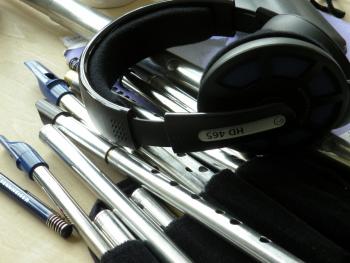
Another Realm Sessions, 2010
Q. What is your favourite track from the new IONA album 'Another Realm' and why is it your favourite?
"Angels Dance" is my favourite track. The opening section always give my heart a lift, it is such a cheerful song and I like the imagery in the lyrics.Q. If you had to choose only one of your instruments to take with you onto a desert island, which one would it be?
The low whistle, mostly because the pipes would be impossible to maintain on a desert island.Continue to Martin's Bio >
THE END
More Gear Pages:
Strict Standards: Non-static method Band::getResults() should not be called statically, assuming $this from incompatible context in /var/www/iona/application/controllers/GearController.php on line 40
Strict Standards: Non-static method Band::getBandMemberById() should not be called statically, assuming $this from incompatible context in /var/www/iona/application/controllers/GearController.php on line 41
Comments (0)




